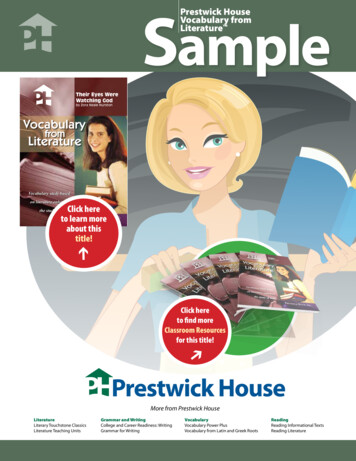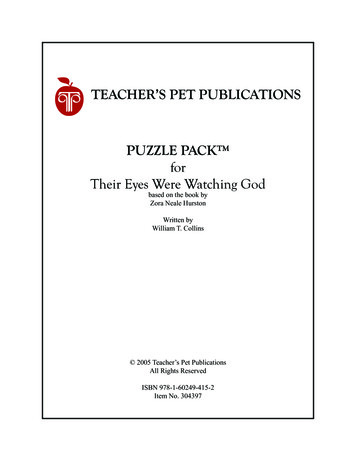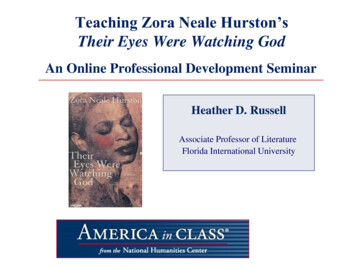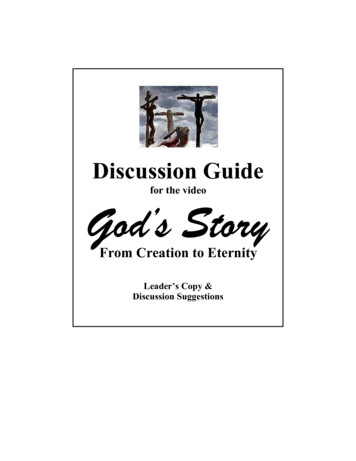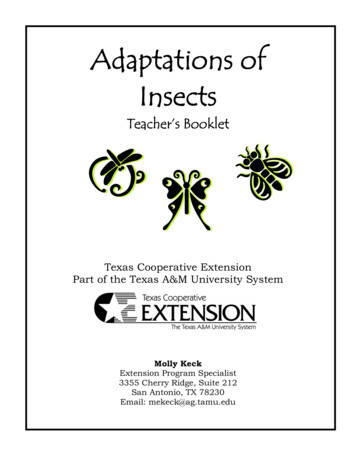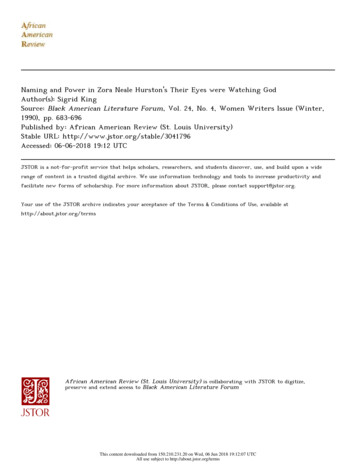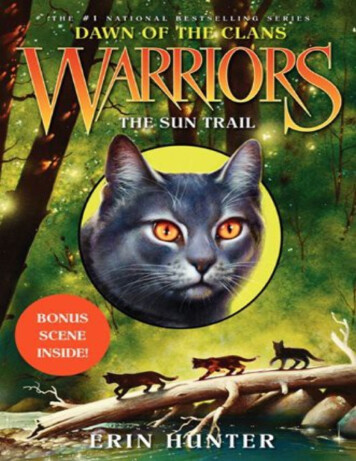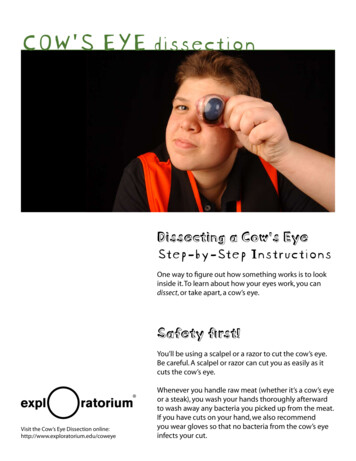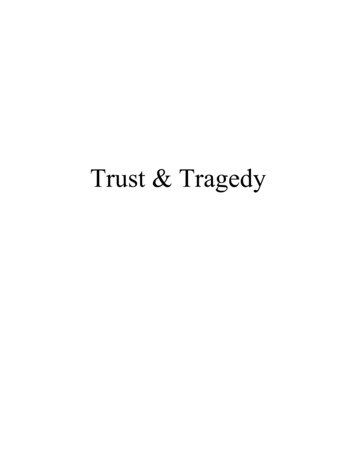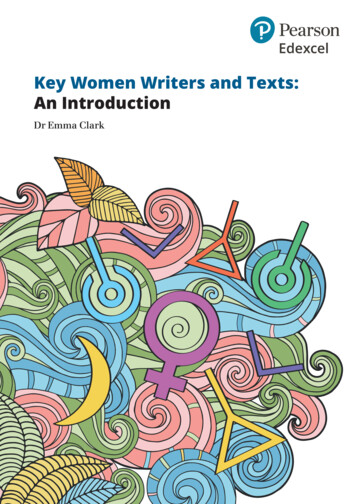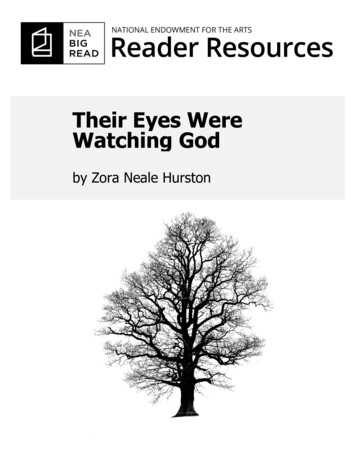
Transcription
Their Eyes WereWatching Godby Zora Neale Hurston1
Table of ContentsTheir EyesWere WatchingGodAbout the Book. 3About the Author . 4Historical and Literary Context . 6Other Works/Adaptations . 8Discussion Questions. 10Additional Resources . 11Credits . 12PrefaceTo call Zora Neale Hurston's Their Eyes Were Watching Godan "African American feminist classic" may be an accuratestatement—it is certainly a frequent statement—but it is amisleadingly narrow and rather dull way to introduce avibrant and achingly human novel. The syncopated beautyof Hurston's prose, her remarkable gift for comedy, thesheer visceral terror of the book's climax, all transcend anylabel that critics have tried to put on this remarkable work.First published amid controversy in 1937, then rescued fromobscurity four decades later, the novel narrates JanieCrawford's ripening from a vibrant, but voiceless, teenagegirl into a woman with her finger on the trigger of her owndestiny. Although Hurston wrote the novel in only sevenweeks, Their Eyes Were Watching God breathes and bleedsa whole life's worth of urgent experience.NEA Big ReadThe National Endowment for the Arts“The wind came backwith triple fury, andput out the light forthe last time Theyseemed to bestaring at the dark,but their eyes werewatching God.”What is the NEA Big Read?A program of the National Endowment for the Arts, NEA BigRead broadens our understanding of our world, ourcommunities, and ourselves through the joy of sharing agood book. Managed by Arts Midwest, this initiative offersgrants to support innovative community reading programsdesigned around a single book.A great book combines enrichment with enchantment. Itawakens our imagination and enlarges our humanity. It canoffer harrowing insights that somehow console and comfortus. Whether you’re a regular reader already or making upfor lost time, thank you for joining the NEA Big Read.2
About the BookIntroduction tothe BookTheir Eyes Were Watching God(1937) begins with our eyesfixed on a woman who returnsfrom burying the dead. Writtenin only seven weeks while on aGuggenheim Fellowship inHaiti, Zora Neale Hurston'snovel chronicles the journey ofJanie Mae Crawford from hergrandmother's plantation shackto Logan Killicks' farm, to allblack Eatonville to theEverglades—until a tragedy brings her back to Eatonville.From this vantage point, Janie narrates her life story to herbest friend, Pheoby Watson, satisfying the "oldest humanlonging—self-revelation."Forced to marry for money at sixteen, Janie at first believesthat love automatically comes with marriage. Unable toendure her mule-like servitude and the desecration of herdreams, she spontaneously leaves Logan for Joe Starks, ahandsome, ambitious man determined to put her on apedestal once he becomes mayor of Eatonville. Afterenduring a mostly joyless twenty-year marriage to him,Janie finally meets a young, uneducated wastrel named TeaCake. With him she thinks she can find genuine love for thefirst time, but fate intervenes, and Janie fears she may haveto choose between his safety and her own.Although the novel is not an autobiography, Hurston oncereflected that it is, at heart, a love story, inspired by "thereal love affair of [her] life." She also fictionalized anotherimportant incident in her life in the novel: In 1929, Hurstonsurvived a five-day hurricane in the Bahamas, getting herselfand another family out of a house moments before it beganto collapse.Hurston's conviction that black culture is valuable, unique,and worthy of preservation comes through in Their EyesWere Watching God via its harmonious blend of folklore andblack idiom. In Janie Mae Crawford, Hurston rejectsnineteenth and early twentieth-century stereotypes forwomen and creates a protagonist who though silenced formost of her life ultimately finds her own voice.NEA Big ReadThe National Endowment for the Arts3
About the AuthorZora NealeHurston(1891-1960)Now lauded as the intellectualand spiritual foremother to ageneration of black andwomen writers, Zora NealeHurston's books were all outof print when she died inpoverty and obscurity in 1960.Born on January 7, 1891, inNotasulga, Alabama, Hurstonand her family soon moved toEatonville, Florida, the first all- Zora Neale Hurston, 1934black incorporated town in the (Yale Collection of AmericanLiterature, Beinecke RareUnited States. Her parentsBook and Manuscript Library)were John Hurston, acarpenter and Baptist preacherwho served several terms as mayor of Eatonville, and LucyPotts Hurston, a schoolteacher before she raised eightchildren. Her mother's death and father's remarriage led theoutspoken Hurston to leave her hometown at fourteen andbecome a wardrobe girl in an all-white traveling Gilbert andSullivan troupe.She completed her education at Morgan Academy inBaltimore and Howard University in Washington, DC,supporting herself with a variety of jobs from manicurist tomaid. Heeding her mother's encouragement to "jump at desun," she arrived in New York in January 1925 with 1.50 inher pocket.Later that year, as the only black scholar at Barnard College,Hurston studied with Dr. Franz Boas, often called the fatherof American anthropology. His encouragement, combinedwith a stipend of 200 a month and a car from patronCharlotte Osgood Mason, allowed Hurston to complete muchof her anthropological work in the American South. Thislifelong passion to collect, record, and broadcast theeveryday idiomatic communication of her people wouldinform four novels, two collections of folklore, anautobiography, and dozens of stories, articles, plays, andessays.This ambition also led to tension in her romantic life.Hurston married and divorced three husbands and, at ageforty-four, fell in love with twenty-three-year-old PercyPunter. When he asked her to forsake her career to marryhim, she refused because she "had things clawing inside[her] that must be said." She wrote Their Eyes WereNEA Big ReadThe National Endowment for the ArtsWatching God, trying in its pages "to embalm all thetenderness of [her] passion for him."Despite the novel's 1937 publication, Hurston's struggle forfinancial security continued throughout the 1940s. Once, sheeven pawned her typewriter. The largest royalty any of herbooks ever earned was 943.75. Since most of her bookswere published during the Depression, she paid her billsthrough story and essay sales, book advances, and twoWorks Progress Administration jobs with the Federal Writers'Project.In the 1950s Hurston remained devoted to writing, but whitepublishers rejected her books, in part because the "NewNegro" had fallen out of fashion. Other complicationsfollowed, and her health seriously declined. Heranticommunist essays and denunciation of school integrationincreasingly alienated her from other black writers. After astroke in 1959, she reluctantly entered a welfare home,where she died penniless on January 28, 1960. Her graveremained unmarked until 1973.Hurston's Death.Their Eyes Were Watching God was published in New Yorkon September 18, 1937. Less than two weeks later, RichardWright (later the author of Native Son and Black Boy)notoriously condemned the novel for carrying "no theme, nomessage, no thought. In the main, her novel is notaddressed to the Negro, but to a white audience whosechauvinistic tastes she knows how to satisfy." He believedthat the novel's lack of anger was one of its greatest faults,as well as its "minstrel technique that makes 'the white folks'laugh."While Wright claimed that Hurston pandered to whites, AlainLocke said she oversimplified Southern black experienceunder the segregationist system known as Jim Crow. InJanuary 1938, Locke's infamous review publicly askedHurston when she would begin to write "social documentfiction." This response so wounded her that she laterregretted writing the novel at all.But critics who felt that Hurston's fiction undermined theirattempts to combat racism misunderstood her aesthetic. Asshe once wrote in a letter, "I tried . . . not to pander to thefolks who expect a clown and a villain in every Negro.Neither did I want to pander to those 'race' people among uswho see nothing but perfection in all of us." Holding to thisvision would cost her, financially and otherwise, right upuntil her death in 1960.4
A decade later, writer Alice Walker was researching a storyon voodoo. She came across Hurston's Mules and Men(1935), which ultimately led Walker to Their Eyes WereWatching God, the book she regards as the most importantof her life.Posing as Hurston's niece, Walker traveled to Eatonville,where she endured many sets of contradictory directionsand found her way at last to the cemetery: the Garden ofHeavenly Rest, on 17th Street. Even there, no one wascertain of the grave's location. The weeds were so thick thatWalker feared snakes might be lurking underfoot. She finallyfound the spot, and she purchased and commissioned aproper stone to mark Hurston's grave.and ResurrectionIn the mid to late 1970s, three important publicationslaunched the Hurston revival that continues to this day.In the March 1975 issue of Ms. Magazine, Walker publishedher article about finding Hurston's grave, titled "In Search ofZora Neale Hurston." Literary scholar Robert Hemenway hadalready been working on the first Hurston biography, whichcame out in 1977. And in 1979, Walker highlighted fourteenprose works in the first-ever Hurston anthology.Hurston's posthumous literary revival also had much to dowith revisions to the literary canon then taking place inuniversity English departments across the United States. Theemergence of feminism and multiculturalism has helpedbring her to the center of the literary stage. But thestrongest voice in Hurston's favor has been her own. Howfitting that the protagonist readers most often associate withZora Neale Hurston is Janie Crawford-a woman who not onlysurvives against long odds, but triumphs.NEA Big ReadThe National Endowment for the Arts5
Historical and Literary ContextThe Life and Timesof Zora Neale Hurston1940s Hurston writes Dust Tracks on a Road in California. America enters World War II after attack at PearlHarbor on December 7, 1941. The war ends in 1945.1890s 1891: Zora Neale Hurston born January 15 inNotasulga, Alabama. Jim Crow laws codified. 1897: John Hurston, Zora's father, is elected mayor ofEatonville, Florida. 1947: Jackie Robinson debuts for the BrooklynDodgers. 1948: President Truman signs orders to end militarysegregation and federal hiring discrimination.1950s Miami Herald article "Famous Negro Author Workingas a Maid" embarrasses Hurston.1900s 1904: Hurston's mother dies; her father remarriesmonths later. 1954: In Brown v. Board of Education, schoolsegregation is ruled unconstitutional. First anti-lynching bill introduced in Congress. It nevergets out of committee. 1955: Rosa Parks refuses to give up her bus seat to awhite man. W. E. B. DuBois publishes The Souls of Black Folk.1910s Hurston leaves Florida, lives in Tennessee, andfinishes her high school education in Baltimore. World War I begins in 1914, and ends in 1919. 1915: Ku Klux Klan reborn in Georgia.1960s 1960: Hurston dies on January 28, of "hypertensiveheart disease," and is buried in an unmarked grave ina segregated cemetery. 1963: Martin Luther King, Jr. delivers "I Have ADream" speech. 1964: Congress passes Civil Rights Act.1920s 1920: Nineteenth Amendment gives women the rightto vote. 1925: Hurston receives degree from HowardUniversity and moves to New York. Busboy Langston Hughes sneaks poet Vachel Lindsaythree poems and hangs up his dishrag for good.1930s 1934: Lippincott publishes Hurston's first novel,Jonah's Gourd Vine, followed by Their Eyes WereWatching God in 1937. During the worst years of the Depression, over 25%of the labor force is unemployed. 1935: FDR launches Federal Writers' Project.NEA Big ReadThe National Endowment for the Arts6
Harlem Renaissance: The EraF. Scott Fitzgerald coined the term "Jazz Age" to reflect anera of ragtime, jazz, stylish automobiles, and uninhibitedyoung women with bobbed hair. But this decade alsomarked the Harlem Renaissance-the artistic, political, andcultural birth of the "New Negro" in literature and art.Scholars rightly have trouble with the term "HarlemRenaissance." Although the great northward migration ledmany African Americans to Harlem, a similar renewal wasalso happening in Chicago, Philadelphia, and Washington,DC, especially through the influence of Louis Armstrong'sand Duke Ellington's jazz. Most of the literary Harlemiteswere not from New York, nor did they depict Harlem life intheir writing—least of all in their fiction. In addition, thedecade is not really a renaissance so much as a creativeoutpouring, a reframing of how Negro artists chose toconvey their African and American heritage. This stance wasno longer one of apology or defeat, but rather of assertionand pride.The beginning of the period most closely coincides withBenjamin Brawley's 1918 book The Negro in Literature andArt in the United States. Alain Locke's 1925 anthology TheNew Negro later synthesized a Negro vision of all the arts,featuring sections on art, music, dance, sculpture, drama,and poetry. He argued that "for generations in the mind ofAmerica, the Negro has been more of a formula than ahuman being-a something to be argued about, condemnedor defended, to be 'kept down,' or 'in his place,' or 'helpedup,' to be worried with or worried over, harassed orpatronized, a social bogey or a social burden."Despite still-flourishing Jim Crow laws, many white New Yorkwriters, publishers, and patrons rallied behind Negro writersand intellectuals, who in turn vociferously protested injusticeand racism. As a result, an environment was created wheremany talented black painters, sculptors, singers, and writersflourished as artists—something new for the grandchildren ofAmerican slavery.Harlem nightclubs and salons also provided opportunities formusicians, actors, writers, and poets to mingle, especially atthe mixed parties hosted by Carl Van Vechten. At thesegatherings, Hurston first met longtime friends such asFannie Hurst and Langston Hughes. As a popular member ofthe Harlem elite, Hurston was known for her Eatonvillefolktales, her radical behavior, her controversial opinions,and her audacious hats.Harlem Renaissance: Hurston'sCircleZora Neale Hurston wrote that New York City was a "longstep for the waif of Eatonville," but the support and criticismof several intellectuals, artists, and patrons helped herbecome one of the movement's most vivacious andcontroversial personalities.One of America 's most popular and highly paid writers ofthe 1920s and '30s, Fannie Hurst (1889-1968) publishedmore than eighteen novels, including Imitation of Life. Sheoriginally hired Hurston as a secretary, but they soonbecame friends. On their frequent trips together they defiedJim Crow laws by eating in restaurants together, but Hurstonwas often forced to sleep in a separate hotel.Like Hurston, poet Langston Hughes (1902-1967) lived inHarlem in the 1920s, published in Alain Locke's The NewNegro, worked on the journal Fire!!, and received awardsfrom Opportunity. When he accompanied Hurston on one ofher Southern folklore-collecting trips, he encouraged her toseek the assistance of his patron, Charlotte Osgood Mason.Hurston's close friendship with Hughes ended after a longdispute over their collaborative play, Mule Bone.Hurston considered Charles S. Johnson (1893-1956) "theroot" of the entire Harlem Renaissance. As editor andfounder of the magazine Opportunity, he published severalof her early stories, including "Sweat." Hurston began acorrespondence with him while she was still a student atHoward University in Washington, DC. He emphaticallyencouraged her to move to New York, a decision thatprofoundly affected her career.Charlotte Osgood Mason (1854-1946) was already the"Godmother" of Hughes and Alain Locke when she metHurston. Under Mason's patronage, Hurston published herfirst anthropological pieces but was forbidden to publishanything else. The one-year contract Hurston signed in 1927was eventually extended until 1931.Some argue that no white person contributed more to theHarlem Renaissance than Carl Van Vechten (1880-1964).As a photographer, writer, and patron of the arts, hepromoted the careers of many artists, including Hughes andHurston. His 1926 novel, Nigger Heaven, split the Harlemelite. His photo collections at Yale and Howard universitiesremain important to this day.Though Hurston's fiction can still be usefully read in thecontext of the Harlem Renaissance, most of her work waspublished after its heyday.NEA Big ReadThe National Endowment for the Arts7
Other Works/AdaptationsHurston and Her Other WorksZora Neale Hurston's writing career took off when Charles S.Johnson published her early short stories, which featuredcharacters altogether unlike those of her contemporaries.Delia Jones from "Sweat" (1926) uses her wits to outsmarther abusive, unfaithful husband. Missie May from "TheGilded-Six Bits" (1933) reclaims her sexuality after bearing achild within her marriage. These women diverged fromprevailing stereotypes for black women in fiction: theoverweight mammy, the tragic mulatto, the promiscuousJezebel.Her unconventional 1942 autobiography, Dust Tracks on aRoad, consciously blurs the line between fact and fiction.She completed the book while employed as a storyconsultant for Paramount Studios in Los Angeles. She barelymentions her first marriage and never mentions her second.She makes no reference to the Great Depression, the twoWorld Wars, or her politics.Hurston continued writing until her death, even thoughpublishers rejected several novels. She died without finishingher last, an ambitious work that would have reimagined thelife of Herod.This complexity deepens in Hurston's novels. The omniscientnarrator of her first novel, Jonah's Gourd Vine (1934),neither indulges nor condemns its errant protagonist, thepreacher John Buddy Pearson. (Hurston drew from herparents' tumultuous history for inspiration here, but theadaptation was far from literal.)During her forty-year writing career, she wrote more thanfifty short stories and essays, many plays, and, in her lastdecade, a series of articles for the Pittsburgh Courier aboutthe sensational trial of Ruby McCullum, a black womancharged with the murder of her white lover, a prominentdoctor.Like Their Eyes Were Watching God (1937), Jonah's GourdVine refuses to dismiss black speech as gibberish. Bothnovels are steeped in folklore, recorded in dialect, anddrenched in poetry. Referring to her first novel, Hurstonwrote: "What I wanted to tell was a story about a man, andfrom what I had read and heard, Negroes were supposed towrite about the Race Problem. I was and am thoroughly sickof the subject. My interest lies in what makes a man or awoman do such-and-so, regardless of his color."Hurston's lonely, little-noticed death does not diminish her.Always a deeply spiritual woman, she wrote in Dust Trackson a Road that "nothing is destructible; things merelychange forms. When the consciousness we know as lifeceases, I know that I shall still be part and parcel of theworld."She continued to explore this interest in her later novels.Moses, Man of the Mountain (1939) blends the OldTestament prophet with the Moses of black folklore toimagine a powerful account of slavery and freedom.Similarly, Seraph on the Suwanee (1948) chronicles thestory of two white Florida "crackers" who are deeply in loveand deeply at odds.Hurston wanted black Americans to turn within to find theircultural and spiritual center: "[U]nless some of the youngNegroes return to their gods, we are lost." For her, thesegods dwelt in the music, dance, and stories of folk culture.The two collections of folklore she published in her lifetimewere remarkable, as no other writer was trying to do whatshe was doing.Mules and Men (1935) was the first great collection of blackAmerican folktales and hoodoo material from New Orleans,including over sixty-five folktales, such as "How Jack Beatthe Devil," "Why Women Take Advantage of Men," and "TheTalking Mule." Her second collection, Tell My Horse (1938),gives an eyewitness account of the mysteries of voodoo inHaiti and Jamaica. The appendix includes Negro songs,another lifelong love of Hurston's.NEA Big ReadThe National Endowment for the Arts8
Selected Works by Hurston Jonah's Gourd Vine, 1934; 1990 Mules and Men, 1935; 1990 Their Eyes Were Watching God, 1937; 1990 Tell My Horse, 1938; 1990 Moses, Man of the Mountain, 1939; 1991 Dust Tracks on a Road, 1942; 1996 Seraph on the Suwanee, 1948; 1991Hurston's publisher during her life was J.B. Lippincott, withthe exception of her last novel, which was republished byScribner. Her reprinted works are published byHarperCollins.Posthumously Published I Love Myself When I Am Laughing.and ThenAgain When I Am Looking Mean and Impressive: AZora Neale Hurston Reader. Ed. by Alice Walker.New York: The Feminist Press, 1979. Mule Bone: A Comedy of Negro Life. Written withLangston Hughes. Edited and with introductions byGeorge Houston Bass and Henry Louis Gates, Jr.New York: HarperPerennial, 1991. The Complete Stories. Introduction by Henry LouisGates, Jr., and Sieglinde Lemke. New York:HarperCollins, 1995. Every Tongue Got to Confess: Negro Folk-Talesfrom the Gulf States. Edited by Carla Kaplan,foreword by John Edgar Wideman. New York:HarperCollins, 2001.NEA Big ReadThe National Endowment for the Arts9
Discussion Questions1.Why does Janie choose to tell her story only to herbest friend Pheoby? How does Pheoby respond atthe end of Janie's tale?2.Hurston uses nature like the pear tree, the ocean,the horizon, the hurricane not only as a plot devicebut also as metaphor. Describe the ways thesefunction as both. Can you think of others?3.The novel's action begins and ends with twojudgment scenes. Why are both groups of peoplejudging her? Is either correct in its assessment?4.Many readers consider the novel a bildungsroman,or coming-of-age novel, as Janie journeys throughthree marriages. What initially attracts her to eachman? What causes her to leave? What does shelearn from each experience?5.In the novel, speech is used as a mechanism ofcontrol and liberation, especially as Janie strugglesto find her voice. During which important momentsof her life is Janie silent? How does she choosewhen to speak out or to remain quiet?6.Is there a difference between the language of themen and that of Janie or the other women? How dothe novel's first two paragraphs point to thesedifferences?7.The elaborate burial of the town mule draws froman incident Hurston recounts in Tell My Horse,where the Haitian president ordered an elaborateCatholic funeral for his pet goat. Although this sceneis comic, how is it also tragic?8.Little of Hurston's work was published during theHarlem Renaissance, yet her ability to tell wittystories and to stir controversy made her a favoriteguest at elite Harlem parties. Identify severalpassages of wit and humor in Their Eyes Were12. Re-read the last three pages of the novel. How dothe imagery and tone connect with other momentsin the novel? Does Janie's story end in triumph,despair, or a mixture of both?Watching God.9.How does the image of the black woman as "themule of the world" become a symbol for the rolesJanie chooses or refuses to play during her quest?10. What do the names of Janie's husbands LoganKillicks, Jody Starks, Vergible "Tea Cake" Woods tellus about their characters and their relationshipswith Janie?11. What kind of God are the eyes of Hurston'scharacters watching? What crucial moments of theplot does the title allude to? Does this God everanswer Janie's questioning?NEA Big ReadThe National Endowment for the Arts10
Additional ResourcesOther Works about Hurston and theHarlem Renaissance Boyd, Valerie. Wrapped in Rainbows: The Life ofZora Neale Hurston. New York: Scribner, 2003. Hemenway, Robert E. Zora Neale Hurston: ALiterary Biography. Urbana: University of IllinoisPress, 1977. Huggins, Nathan. Harlem Renaissance. New York:Oxford University Press, 1971. Hurston, Lucy Anne, and the Estate of Zora NealeHurston. Speak, So You Can Speak Again: The Lifeof Zora Neale Hurston. New York: Doubleday, 2004. Kaplan, Carla, ed. Zora Neale Hurston: A Life inLetters. New York: Doubleday, 2002. Walker, Alice. In Search of Our Mothers' Gardens.New York: Harcourt, 1983. Wall, Cheryl A. Women of the Harlem Renaissance.Bloomington: Indiana University Press, 1995.If you want to read other novelistsinfluenced by Hurston, you mightenjoy: Toni Morrison's Jazz, 1992 Gloria Naylor's The Women of Brewster Place, 1982 Alice Walker's Meridian, 1976If you want to read other writers ofthe Harlem Renaissance, you mightenjoy: Langston Hughes's The Weary Blues, 1926 James Weldon Johnson's The Book of AmericanNegro Poetry, 1922 Jean Toomer's Cane, 1923NEA Big ReadThe National Endowment for the Arts11
CreditsWorks CitedExcerpts from Their Eyes Were Watching God 1937,1965; Dust Tracks on a Road 1942, 1970, by Zora NealeHurston are reprinted by permission of HarperCollinsPublishers.Hurston, Zora Neale. Dust Tracks on a Road. 1942, 1970.New York: HarperCollins, 1992.---. "How It Feels to Be Colored Me." I Love Myself When IAm Laughing . and Then Again When I Am Looking Meanand Impressive: A Zora Neale Hurston Reader. Ed. AliceWalker. New York: Feminist Press, 1979.The National Endowment for the Arts was established byCongress in 1965 as an independent agency of the federalgovernment. To date, the NEA has awarded more than 5billion to support artistic excellence, creativity, andinnovation for the benefit of individuals and communities.The NEA extends its work through partnerships with statearts agencies, local leaders, other federal agencies, and thephilanthropic sector.---. Their Eyes Were Watching God. 1937, 1965. NewYork: HarperCollins, 1990.Hughes, Langston. The Big Sea. 1940. New York: Hill andWang, 1993.Kaplan, Carla, ed. Zora Neale Hurston: A Life in Letters. NewYork: Doubleday, 2002.Locke, Alain, ed. The New Negro: Voices of the HarlemRenaissance. 1925. New York: Touchstone, 1997.Wright, Richard. "Between Laughter and Tears." NewMasses 5 October 1937: 22-5.AcknowledgmentsArts Midwest promotes creativity, nurtures culturalleadership, and engages people in meaningful artsexperiences, bringing vitality to Midwest communities andenriching people’s lives. Based in Minneapolis, Arts Midwestconnects the arts to audiences throughout the nine-stateregion of Illinois, Indiana, Iowa, Michigan, Minnesota, NorthDakota, Ohio, South Dakota, and Wisconsin. One of six nonprofit regional arts organizations in the United States, ArtsMidwest’s history spans more than 30 years.All images of Zora Neale Hurston used with the permissionof the Estate of Zora Neale HurstonWriters: Erika Koss and David Kipen for the NationalEndowment for the Arts.Cover image: Derivative of "Tree Silhouette" by eaglesaerieCC BY-NC-SA 2.0 via Flickr. Cover image licensed under CCBY-NC-SA 4.0 by Arts Midwest.NEA Big Read Reader Resources are licensed under a CreativeCommons Attribution-NonCommercial-NoDerivatives 4.0 InternationalLicense. Arts MidwestNEA Big ReadThe National Endowment for the Arts12
To call Zora Neale Hurston's Their Eyes Were Watching God an "African American feminist classic" may be an accurate statement—it is certainly a frequent statement—but it is a misleadingly narrow and rather dull way to introduce a vibrant and achingly human novel. The syncopated beauty of Hurston's prose, her remarkable gift for comedy, the
